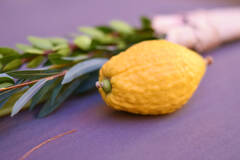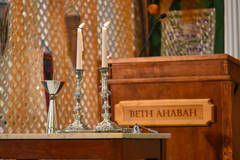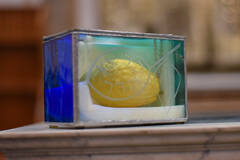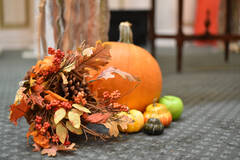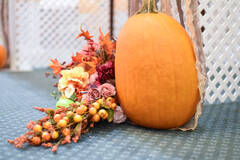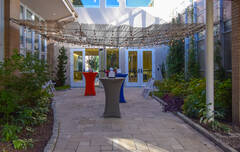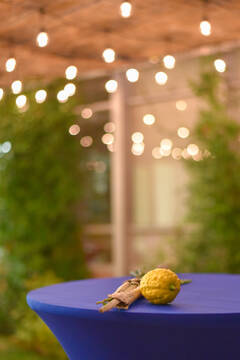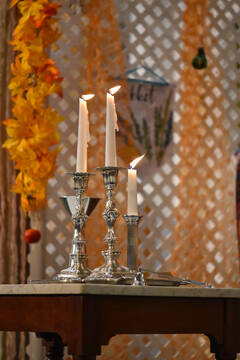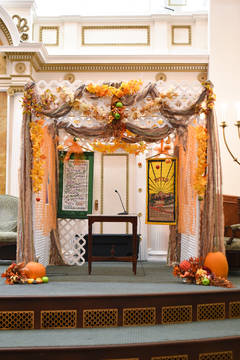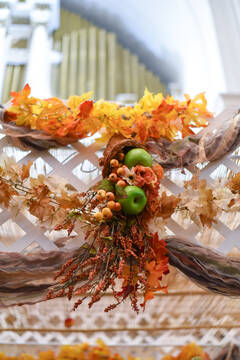Sukkot Resources
Sukkot Resources
Page Contents: What is Sukkot? | What do I need to celebrate Sukkot at home? | Zoom Backgrounds & Other Resources
Sukkot is one of the most joyful festivals on the Jewish calendar. “Sukkot,” a Hebrew word meaning "booths" or "huts," refers to the Jewish festival of giving thanks for the fall harvest. The holiday has also come to commemorate the 40 years of Jewish wandering in the desert after the giving of the Torah atop Mt. Sinai.
Also called Z’man Simchateinu (Season of Our Rejoicing), Sukkot is the only festival associated with an explicit commandment to rejoice. Sukkot is celebrated five days after Yom Kippur on the 15th of the Hebrew month of Tishrei, and is marked by several distinct traditions. One, which takes the commandment to dwell in booths literally, is to erect a sukkah, a small, temporary booth or hut. Sukkot (in this case, the plural of sukkah) are commonly used during the seven-day festival for eating, entertaining and even for sleeping.
Our sukkot have open walls and open doors, and this encourages us to welcome as many people as we can. We invite family, friends, neighbors, and community to rejoice, eat, and share what we have with each other.
Another name for Sukkot is Chag HaAsif (Festival of the Ingathering), representing the importance in Jewish life of giving thanks for the bounty of the earth.
from "Sukkot" at ReformJudaism.org
What is Hoshana Raba?
The last day of Sukkot, called Hoshana Raba, has special customs that are different than during the rest of Sukkot. Hoshana Raba is considered to be Chol HaMoed, an intermediate day of Sukkot, yet it has special Festival prayers and rituals not done on any of the other days of Chol HaMoed. Traditionally, the congregation marches with the lulav and etrog seven times around the Sanctuary saying prayers called hoshanot (prayers for God's saving power). In part, this commemorates the services in the ancient Temple in Jerusalem, when the priests would circle the altar seven times on Hoshana Raba.
In some communities, after these seven hakafot (processionals) they would take the willow branches (aravot) out of the lulav bundle and hit them on the ground! This comes from the tradition that Hoshana Raba is the last true day of the High Holy Day season, and hitting the willows is supposed to symbolize getting rid of any of our remaining sins. This custom is also connected with an ancient belief that the sins of the community might influence God's decision to begin the rainy season on time. Some communities blow the shofar, which is another connection between this day and the High Holy Days.
Sukkot Basics: "What do I need to celebrate Sukkot at home?"
5 Sukkot Activities You Can Do With What You Have At Home
Sukkah
The sukkah symbolizes the frail huts in which the Israelites lived during their 40 years of wandering in the desert after the Exodus from Egypt. It also serves to remind Jews of the biblical account of how God protected them, provided for their needs in the wilderness, and by implication, still watches over us today.
Sukkot come in many variations, but there are some guidelines to follow when building them. Two important ones are:
1. A sukkah has to have at least two and a half walls, and at most four walls. The walls may be constructed of any material, generally canvas, wood or metal, including pre-existing walls of permanent structures, like the side of your house. It is possible to buy ready-to-assemble sukkah kits, or come up with your own design!
2. The roof must be temporary, made by covering the top of the sukkah with anything that grew out of the ground and has been cut off from the ground, such as branches from trees, bamboo or reed mats, etc. According to tradition, this roof covering, s’chach, should give shade and yet allow those in the sukkah to see the stars through the roof at night.
Once the sukkah is built, it is common to decorate it by hanging fruit (real or pretend) and other items from the s’chach, putting posters on the walls, and even laying carpet on the floor.
from "Sukkot Customs and Rituals"
Lulav & Etrog
Sukkot celebrates the fall harvest, expressed by blessing and waving the lulav and the etrog, symbols of the harvest; by building and decorating a sukkah; and by extending hospitality to friends and family. The lulav is a combination of date palm, willow and myrtle branches, held together by a woven palm branch. The etrog, or citron, is a lemon-like fruit with a wonderful citrus smell. When reciting the blessing over the lulav and etrog, one should wave them in six directions—north, south, east, west, up, and down. This action symbolizes that God can be found in all directions, not only in one particular place. from "Sukkot Customs and Rituals"
If you don't have access to all those plants, try gathering 4 examples of local plants which exhibit the following traits:
1. does not bear fruit, does not have a wonderful aroma (like the willow fronds)
2. does bear fruit, does not have a wonderful aroma (like the date palm frond)
3. does not bear fruit, does have a wonderful aroma (like the myrtle fronds)
4. does bear fruit, does have a wonderful aroma (like the etrog/citron)
Let us know what local plants you come up with in these categories!
Ushpizin (special Sukkot guests):
Click here for a list of Biblical ushpizin along with some questions for personal reflection.
Click here to see how Shalom Sesame explores the Mitzvah of Welcoming Guests.
More Sukkot Resources & Helpful Links
For an online version of the blessings recited on Sukkot, click here.
Click here to browse the entire collection of Sukkot articles at ReformJudaism.org or see below for more!
Click any image below to download a full-resolution version,
which can be used as a phone or desktop background, or virtual background on Zoom!
(photos below by Sarah Roper)
More Information: History of Sukkot, A Savory Sukkot, 9 Things Know About Sukkot
A connection between voting and Sukkot? click here to learn more!
Recipes: 14 Recipes for a Festive Sukkot
Decorations: Sukkot Decorations to Make with Young Children, Decorative Paper Lanterns for Sukkot
Special Torah Readings for Sukkot: Torah Reading on the First Day of Sukkot, Torah Reading during Chol HaMo-eid (the intermediate days) of Sukkot, Chol HaMo-eid Sukkot Commentary for Tweens
Wed, November 5 2025
14 Cheshvan 5786
Events
-
Thursday ,
NovNovember 6 , 2025Torah Study
Thursday, Nov 6th 12:00p to 1:00p
-
Friday ,
NovNovember 7 , 2025Oneg
Friday, Nov 7th 5:45p to 6:15p
-
Friday ,
NovNovember 7 , 2025Shabbat Service
Friday, Nov 7th 6:15p to 7:15p
-
Friday ,
NovNovember 7 , 2025First Friday Shabbat Dinner & Activities
Friday, Nov 7th 7:15p to 9:00p
-
Sunday ,
NovNovember 9 , 2025Religious School
Sunday, Nov 9th 9:15a to 11:45a
Join Our Mailing List
Why ShulCloud?
Privacy Settings | Privacy Policy | Member Terms
©2025 All rights reserved. Find out more about ShulCloud

